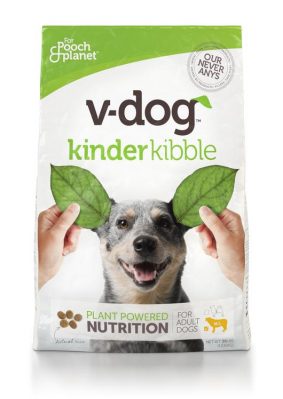
I’m not a fan of vegan or vegetarian dog foods, and the science is so terribly flawed (read this), but I find V-Dog dog food comes across the best of the bunch.
The reason for this is the formula feels more balanced and more digestible than other vegan dog foods. Let’s walk through those ingredients so you can decide for yourself if V-Dog is right for you and your dog.
If you’re willing to compromise a little then there are some great pescetarian dog foods, such as the Taste of the Wild and Canidae Pure brands, which are well worth looking at.
Let’s take a good look at Californian brand V-Dog:
My thoughts on vegan diets
If you read about the Griffith University study I linked to earlier, then you will have a really good base of understanding vegan dog foods. If anything, science shows they can be healthier than the average grain-based kibble.
For this reason, it’s possible for a dog to be healthier on a vegan dog food than a supermarket dog food.
My belief is dogs can live a far healthier life if not fed those grain-based or budget dog foods, and you should too – ultra processed junk.
V-Dog review
The main ingredients of V-Dog are peas and pea protein, so essentially a double-whammy of peas.
There are health concerns with dogs fed too much pea, but as an ingredient in a vegan dog food they’re readily available, sustainable, and (for the benefit of the manufacturer) cheap. If you’re concerned about your dog consuming too much pea then rotate between other brands – problem solved.
The benefits of peas are they’re rich in protein, and dogs tend to do better on protein-based foods rather than carbohydrate or starchy foods.
Considering the amount of peas in V-Dog, and how cheap peas are as an ingredient, you would expect the food to be cheap. It isn’t, because most vegan dog owners are willing to pay a premium for an ethical product.
The next set of ingredients are carbohydrates, and although science suggests dogs are omnivores (a “fact” very convenient for the producers of grain-based dog foods who fund and instigate scientific studies), carbs are harder for your dog to digest.
The reason is also scientific, as the short digestive tract of a dog is closer to that of a cat than us of a human. This can make carbohydrates hard to process in the time it takes for the rock hard nuggets of kibble to pass through the system and out the other end.
This set of ingredients is a combination of brown rice, oatmeal, potato protein (okay, not a carb, but you get my point), and sorghum.
Like peas, these are also relatively cheap ingredients. Especially when compared to meat ingredients. Do you think this is reflected in the price?
The fat content of V-Dog sits around 9%. That’s low, and suggests another problem which is lots of carbohydrates. Protein is 24%, and by my calculations that means almost 50% carbohydrates – that shows the emphasis of potato, oatmeal, and sorghum to peas.
Dog’s utilise fats very efficiently for energy.
Canola oil isn’t the best choice of oil, but being a vegan food they can’t use anything like fish oil as a better source of omega fats.
Other ingredients offer much needed omega 3 and 6, including flaxseed and sunflower chips, but these are so far down the ingredients list you have to wonder how beneficial they are. In fact, when you consider most of these ingredients are likely 1% or less of the formula, you have to wonder if they’re included because they look good on the label?
Other ingredients really highlight this as a vegan food – lentils, quinoa, alfalfa – which may add some benefit. The fruits and vegetables listed right at the end of the ingredients, after the vitamin and mineral inclusions, we can assume are nothing more than specks.
To wrap up, there are no added probiotics to aid digestion, and none of the minerals are chelated – just regular inclusions. Given this is a vegan dog food product, backed by dubious science, it would be nice to see more absorbable chelated minerals to ensure your dog gets what they need.
Price wise it’s very expensive per kilo if you consider there’s no meat content, and the ingredient inclusions are relatively cheap. It’s also very low in fat, and dogs utilise fat (animal fat) for energy.
Overall for a vegan food it’s better than others reviewed. Dare I say it, but if you add raw meat to this you’ll be offering your dog a decent diet.
Where to buy
Vegan dog food is generally harder to source, sometimes being limited to a select few retailers.
Ingredients
Ingredients of V-Dog dog food:
Dried Peas, Pea Protein, Brown Rice, Oatmeal, Potato Protein, Sorghum, Canola Oil (preserved with Mixed Tocopherols), Natural Flavor, Suncured Alfalfa Meal, Brewers Dried Yeast, Dicalcium Phosphate, Flaxseeds, Millet, Calcium Carbonate, Lentils, Peanut Hearts, Quinoa, Sunflower Chips, Salt, Marine Microalgae (source of DHA), Potassium Chloride, Dried Chicory Root Inulin, Choline Chloride, Taurine, Vitamins (Vitamin E Supplement, Vitamin A Supplement, Niacin Supplement, d-Calcium Pantothenate, Riboflavin Supplement, Vitamin D2 Supplement, Thiamine Mononitrate, Vitamin B12 Supplement, Pyridoxine Hydrochloride, Biotin, Folic Acid), Dried Carrots, Minerals (Ferrous Sulfate, Zinc Sulfate, Copper Sulfate, Sodium Selenite, Manganese Sulfate, Calcium Iodate), DL-Methionine, Dried Parsley, L-Ascorbyl-2-Polyphosphate (source of Vitamin C), preserved with Citric Acid, preserved with Mixed Tocopherols, Dried
Celery, Dried Blueberries, Dried Cranberries, Dried Beets, Yucca Schidigera Extract, Dried Lettuce, L-Carnitine, Dried Watercress, Dried Spinach, Rosemary Extract.
Guaranteed analysis
The guaranteed analysis of V-Dog dog food:
| Protein | (min) 24% |
| Fat | (min) 9% |
| Crude Fibre | (max) 5% |
| Carbohydrates * | Estimated 49% |

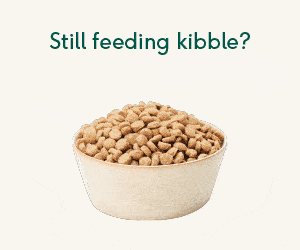


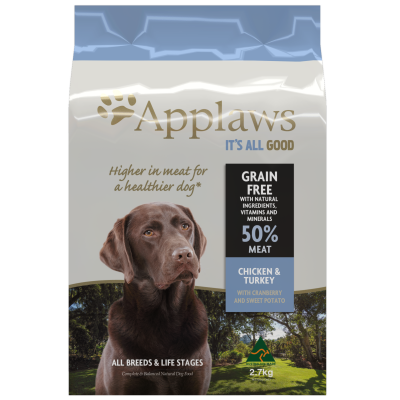
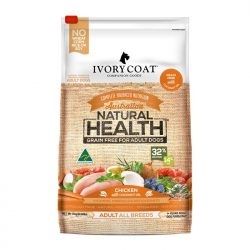

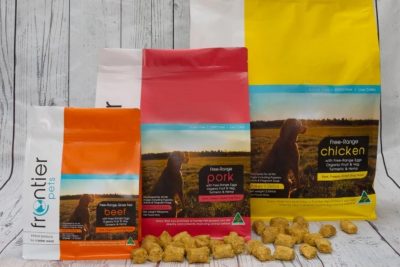
Neither of the cited retailers seem to sell this dog food in Australia. Happy to stand corrected though.
Also, you may find this interesting
https://www.theguardian.com/lifeandstyle/2022/apr/13/vegan-diets-are-healthier-and-safer-for-dogs-study-suggests
Hi Sophie, thanks for adding the article, and I’ll correct the cited retailers as well.
I’ll also add the link to the survey as I always find this stuff interesting – https://journals.plos.org/plosone/article?id=10.1371/journal.pone.0265662
I find the survey flawed on many counts, and note it’s a survey not controlled research. They’re important points The Guardian has neglected to mention (which is common with The Guardian!).
Personally I would say some vegan diets, even the kibble diets, are better than many “meat-based” kibbles, which is something which can also be deduced from the survey.
I note no brands have been mentioned, only the categorisation of “conventional meat based diets”. The sad reality is not many dry dog foods are meat-based, they’re almost all grain-based (or carbohydrate based).
A survey which spans only a year can suggest very little. I find with most conditions it can take many years for our resilient pets to even show symptoms. In fact, I would say a dog can be fed an unhealthy diet for as much as 7 years before showing any signs of sickness, such as from renal failure, heart disease, periodontal disease, diabetes and so forth. Or to look at it another way, a dog can be fed a diet of anything for a year, and any required vet visits can be completely multifactorial. The cause of the visit may have been diet-related from the current food, but also the previous food, or it could be viral (such as parvo) or environmental.
The survey found health issues were reported in the ratios of 49% for the conventional (poor quality kibble?) diet, 43% for the raw meat diet, and 36% for the vegan diet. They’re not very conclusive margins considering the lack of control of the survey.
The survey
Bringing your willfully ignorant prejudices to work is not OK when these people have given you all the evidence you need to understand the nutritional needs of dogs.
https://v-dog.com/blogs/veterinarians
https://v-dog.com/blogs/v-dog-blog/bramble-the-collies-secrets-to-living-to-age-25
“Daring to say it” will end the lives of animals that you are unnecessarily responsible for. At some point in the future your remarks may be thought of as criminal.
I don’t think I’m a criminal for pointing out a canine is a carnivorous animal, regardless of what the manufacturer says.
Simple.
Facts.
“Dare I say it, but if you add raw meat to this you’ll be offering your dog a decent diet.”
Love it haha.
I’ve actually had a similar thought tbh (just wouldn’t do it due to the price and reasons 😉 although I’d consider using it as a training treat to mix things up)
I am not a fan of feeding dogs (albeit facultative carnivores are still carnivores!) a plant based diet if there are more appropriate options available but at the end of the day the market for vegan dog food is growing so it would be nice to see (from a nutritional standpoint) higher protein (preferably in the low to mid 30s) and higher fat to offset the less complete proteins found in plants (with the added benefit of lowering carbohydrate %).
Which could be achieved fairly easily by pushing lentils up much higher on the ingredients list and including chickpeas close to the top too (MfM does that and their food is slightly cheaper than this!), and bumped sorghum down bellow to the last of the main ingredients, after quinoa.
The addition of nutritional yeast would also be highly beneficial (and would make the price *almost* justifiable).
The addition of algae oil would introduce much needed sources of marine omega 3 (DHA/EPA; more bioavailable than ALA) whilst still remaining “vegan”.
Coconut oil wouldn’t add much on the micronutrient front but at least it would boost the fats on the macronutrient front so would also be a good addition.
It’s a pity they don’t make changes like that because even though vegan will never be species appropriate they could at least make it more nutritionally appropriate for the dogs that are fed that as their primary source of nutrition…